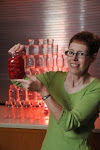From Orchard to Table, Via Canning, Drying and Freezing
Many apple varieties grown in Wisconsin are ripening on the tree, so orchards and markets around the state have delicious fruit ready to be sampled. These apples can be eaten fresh or baked into pies, but there are also options for individuals looking to preserve the fall bounty well past winter.
Apples lend themselves very well to canning, drying and freezing, according to Ingham. And while each preserving method has different safety concerns, there are some general guidelines for selecting apples to preserve. It is important to take special care in choosing late season produce. Fruits and vegetables that have become overripe and soft should not be used for canning, freezing or drying.
Apples allowed to ripen on the tree will be the sweetest. Using damaged fruit or apples that have fallen to the ground (drops) is not recommended. Overripe or damaged fruit may have lower levels of acid, allowing pathogens to gain a foothold when the fruit is preserved. Similarly, apples that have fallen to the ground may have become contaminated with animal waste and may carry harmful bacteria.
Many light-colored fruits like apples also darken very quickly when peeled; antioxidant treatments like ascorbic acid, vitamin C, can help prevent a color change, no matter how the apples are preserved. Ascorbic acid can be sprinkled on to fruit, mixed with water to create a dip or added to the fruit juice or syrup that frozen or canned apples will be packed in.
Home-drying apples can be done in a dehydrator or the oven. It is important that dried fruits be cut into even pieces. Apples can be sliced in rings, wedges or chips, with the core removed, and when placed on trays to dry, they should be evenly spaced with no pieces touching. Drying apples can be a lengthy process: It can take between 12 and 24 hours in the oven at a very low temperature (125 degrees F). Because of the lengthy time in the oven, a commercial dehydrator is often an excellent choice for drying fruit. Choose a dehydrator with a heater and fan strong enough to dry fruit efficiently. Set the dehydrator to 125 degrees F and allow apples to dry until they are still flexible but no longer sticky.
When canning and freezing apples, it is important to use the correct equipment and make sure heated foods reach the right temperature. Use rigid freezer containers of plastic, glass or wax-coated paper to prevent freezer burn and keep frozen fruits safe.
Use current, research-tested recipes for all home food preservation. Just because a recipe is in print, doesn’t mean it’s safe for you and your family. Canning recommendations have changed dramatically over the last 15 years, so if you are using recipes that date before 1994, then it’s a good idea to set those aside and find an up-to-date recipe that has been tested for safety. It is also important to make sure all equipment used in home food preservation, such as boiling water or pressure canners and electric dehydrators, is in good working order.
Source: Barbara Ingham, UW-Extension Food Safety Specialist





No comments:
Post a Comment